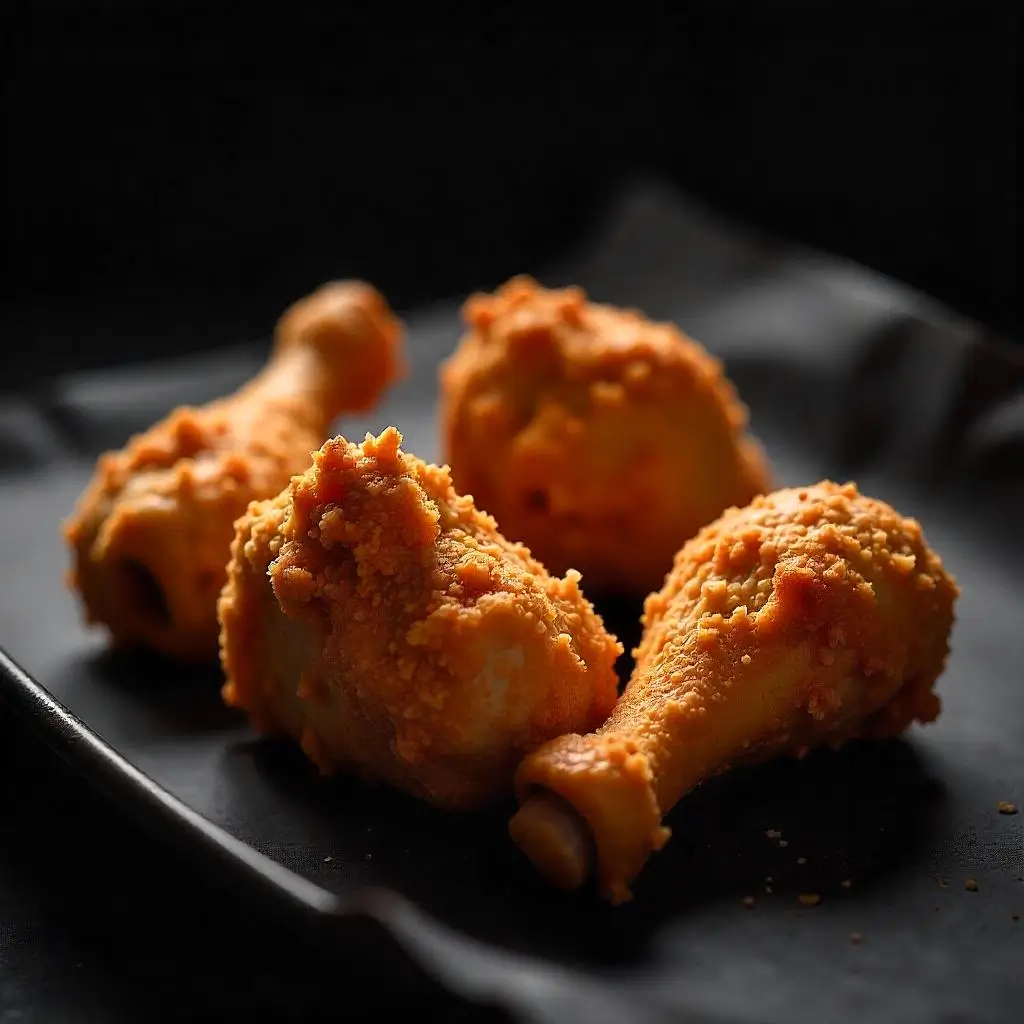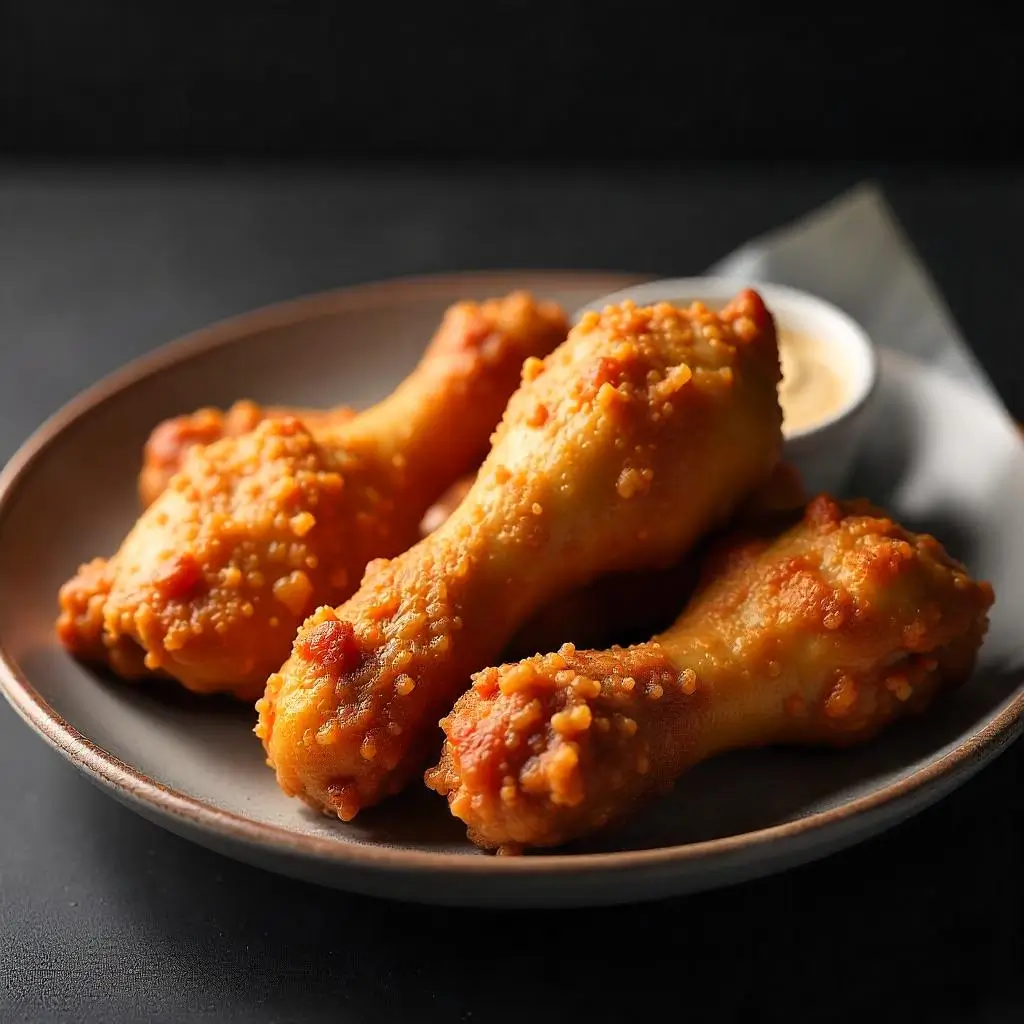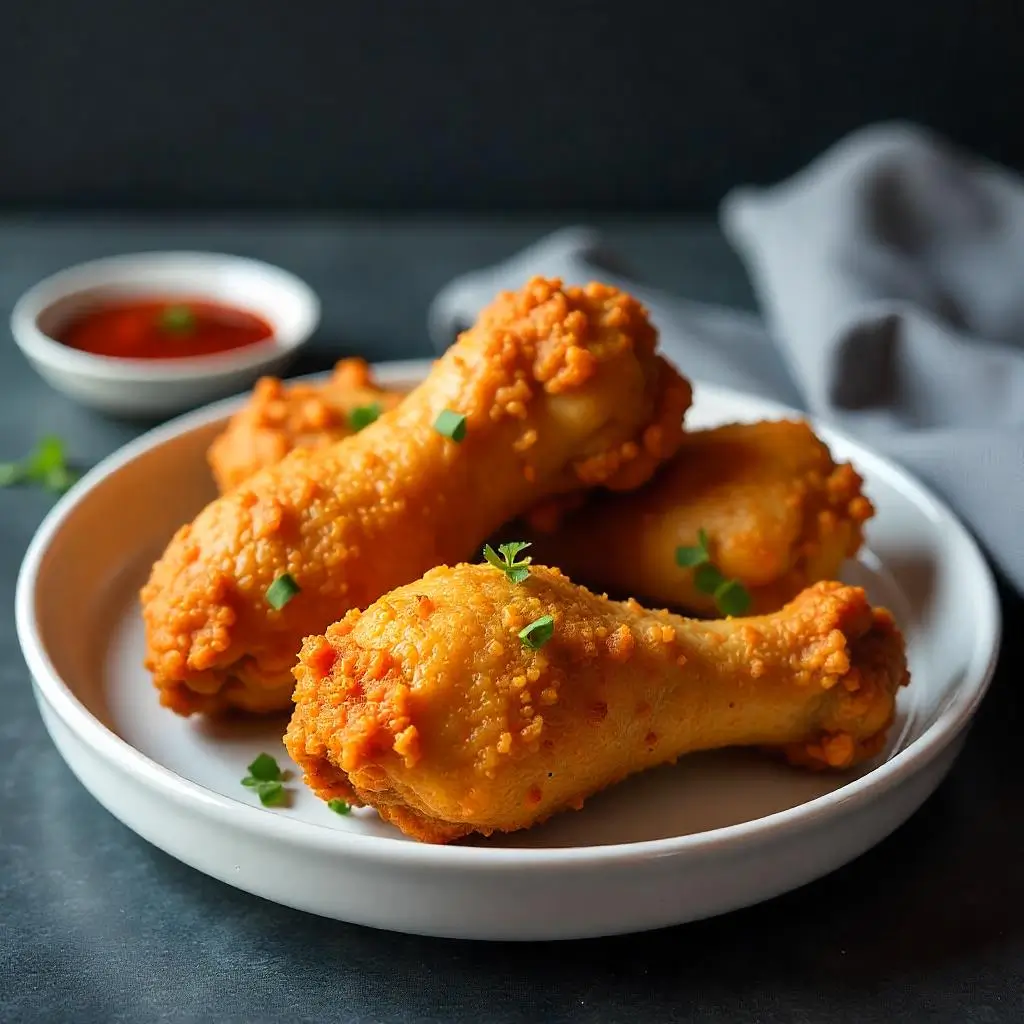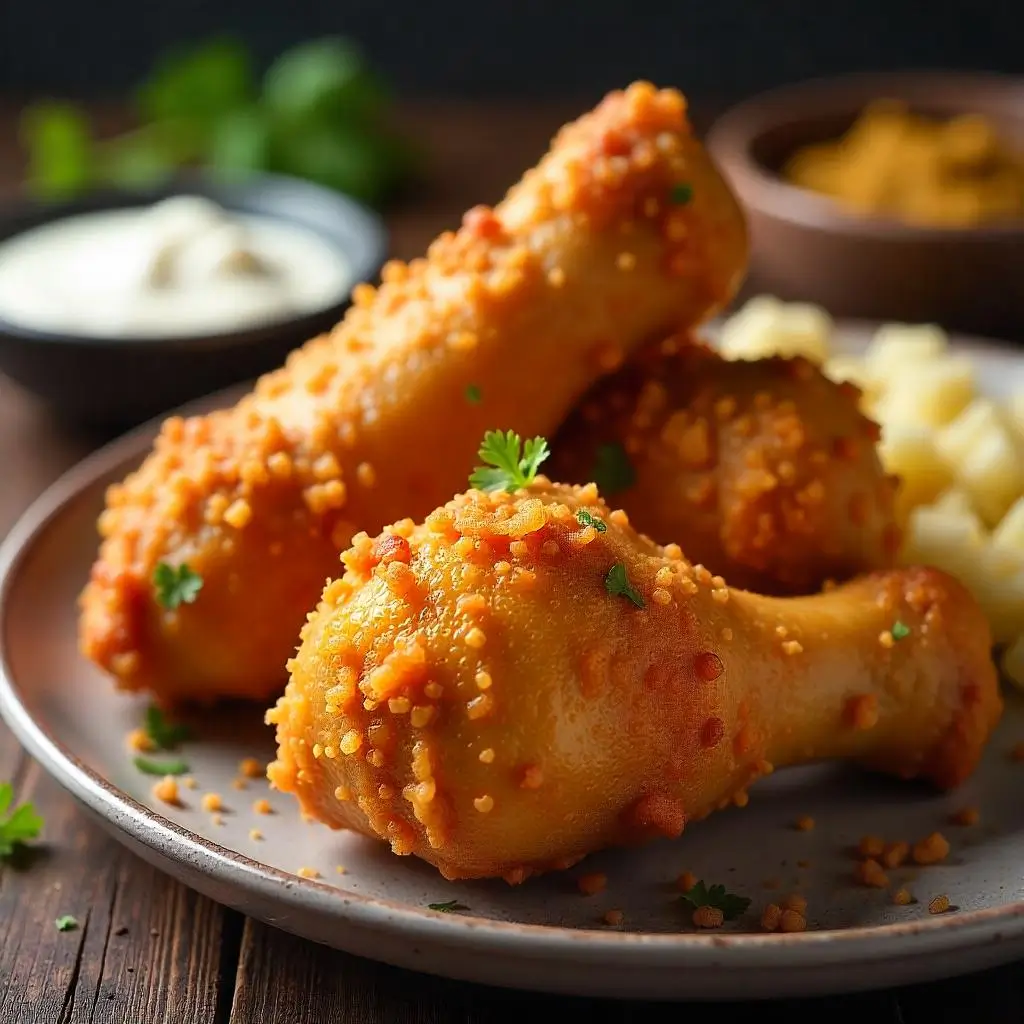Are you craving perfectly crispy fried chicken drumsticks that deliver an incredible crunch with every bite? Furthermore, this easy recipe requires minimal ingredients while producing restaurant-quality results. Most importantly, you’ll achieve that coveted golden-brown exterior with tender, juicy meat inside. In fact, this might just be the best crispy fried chicken legs recipe you’ll ever try!
Table of content

Essential Ingredients
For the Dry Coating:
- 2 cups all-purpose flour
- 1 tablespoon garlic powder
- 2 tablespoons paprika
- 1 tablespoon onion powder
- 1 teaspoon cayenne pepper
- 2 teaspoons salt
- 1 teaspoon black pepper
For the Wet Mixture:
- 1 cup whole milk
- 2 large eggs
- 1 teaspoon salt
- 1/2 teaspoon black pepper
Additional Ingredients:
- 8-10 chicken drumsticks
- Vegetable oil for frying
Step-by-Step Instructions
Preparing the Coating Mixtures
Initially, combine all dry ingredients in a large bowl, whisking thoroughly to ensure even distribution. Meanwhile, prepare the wet mixture by beating eggs with milk and seasonings until well combined.
The Triple-Coating Process
The secret to achieving maximum crispiness lies in the three-step breading process. First, dredge each drumstick in the seasoned flour mixture, coating completely. Then, dip the floured drumstick into the wet mixture, allowing excess to drip off. Finally, return the drumstick to the flour mixture for a second coating.
For extra crispiness, consider adding a tablespoon of the wet mixture to the dry ingredients and mixing with your fingers. This technique creates small clumps that result in an even more textured, crunchy coating.
Oil Preparation and Frying
Heat your oil to exactly 350 degrees Fahrenheit in a heavy-bottomed pot or deep fryer. Maintaining this temperature is absolutely critical for achieving the perfect texture. Subsequently, carefully lower the coated drumsticks into the hot oil, being careful not to overcrowd the pot.
Fry the drumsticks over medium heat for approximately 12-15 minutes, turning them halfway through the cooking process. The chicken should develop a beautiful golden-brown color while reaching an internal temperature of 165 degrees Fahrenheit.
Once cooked, transfer the drumsticks to a wire rack or paper towel-lined plate to drain excess oil. Allow them to rest for 5 minutes before serving, as this helps the coating set properly.

Frequently Asked Questions
How Long Does It Take to Fry Chicken Legs?
Typically, chicken drumsticks require 12 to 15 minutes of frying time at 350 degrees Fahrenheit. However, cooking time may vary depending on the size of your drumsticks. Therefore, always use a meat thermometer to verify that the internal temperature reaches 165 degrees Fahrenheit.
Why Is My Fried Chicken Not Crispy?
The most common reason for soggy fried chicken is oil temperature that’s too low. When oil temperature drops below 350 degrees, the coating absorbs excess oil instead of creating that desired crispy exterior. Consequently, maintaining consistent heat throughout the frying process is essential.
Additionally, overcrowding the pot causes the oil temperature to drop significantly, resulting in greasy, non-crispy coating. Instead, fry in small batches to maintain optimal temperature and texture.
Expert Tips and Additional Notes
Choosing the Right Oil
For best results, use oils with high smoke points such as vegetable oil, canola oil, or peanut oil. These oils can withstand the high temperatures required for deep frying without breaking down or imparting unwanted flavors.
Should You Wash Chicken Before Cooking?
Contrary to popular belief, washing raw chicken is not recommended by food safety experts. Instead, pat the drumsticks dry with paper towels before seasoning and coating. This approach removes surface moisture while preventing cross-contamination in your kitchen.
Ensuring Even Cooking
Choose drumsticks of similar size to ensure uniform cooking times. If you have significantly larger or smaller pieces, adjust cooking times accordingly and monitor internal temperatures carefully.
Delicious Variations
Spicy Buffalo Style Transform your drumsticks by tossing them in buffalo sauce immediately after frying. Combine 1/2 cup hot sauce with 4 tablespoons melted butter, then coat the crispy drumsticks while they’re still warm. Serve with ranch dressing and celery sticks for an authentic buffalo experience.
Honey Garlic Glazed Create an irresistible sweet and savory combination by brushing the fried drumsticks with honey garlic glaze. Mix 1/3 cup honey, 3 minced garlic cloves, 2 tablespoons soy sauce, and 1 tablespoon rice vinegar. Heat the mixture until bubbling, then brush over the cooked drumsticks.
Korean-Style Crispy Chicken For an Asian twist, add 2 tablespoons cornstarch to your flour mixture and incorporate gochujang (Korean chili paste) into the wet ingredients. After frying, toss with a glaze made from gochujang, honey, soy sauce, and sesame oil.
Herb-Crusted Version Enhance the traditional recipe by adding 2 tablespoons of dried herbs such as thyme, rosemary, and oregano to your flour mixture. This variation creates a more aromatic and sophisticated flavor profile perfect for dinner parties.
Buttermilk Marinated Although the basic recipe doesn’t require marinating, you can elevate the flavor by soaking drumsticks in seasoned buttermilk for 2-4 hours before coating. This technique results in even more tender meat with enhanced flavor penetration.

The Popularity of Chicken Drumsticks
Without a doubt, chicken drumsticks remain one of the most beloved cuts of poultry. Additionally, their natural handle makes them perfect for gatherings, family dinners, and casual entertaining. Moreover, drumsticks are incredibly affordable compared to other chicken parts, making them an excellent choice for feeding a crowd.
The key to exceptional fried chicken drumsticks lies in the perfect blend of seasonings. Specifically, our signature spice mix includes paprika, garlic powder, onion powder, cayenne pepper, and black pepper. Subsequently, these spices create layers of flavor that penetrate the meat while contributing to that irresistible crispy coating.
When serving your crispy fried chicken drumsticks, consider pairing them with classic sides like coleslaw, mashed potatoes, or corn on the cob. Alternatively, you can create a complete Southern-style feast by adding biscuits and gravy to the menu.
Alternative Cooking Methods and Related Recipes
While traditional deep frying produces the ultimate crispy texture, you might also enjoy our Air Fryer Chicken Legs recipe for a healthier alternative. Similarly, our collection includes various chicken leg recipes that showcase different cooking techniques and flavor profiles.
For those seeking more poultry inspiration, be sure to explore our other favorite chicken recipes, including buffalo wings, chicken tenders, and herb-roasted whole chicken.
How Do I Make Flavorful Crispy Fried Chicken Legs?
Creating the perfect crispy fried chicken legs involves understanding the science behind the coating process. First, you’ll need wet ingredients including milk and eggs, though you can certainly substitute buttermilk for extra tang. Next, the dry mixture combines all-purpose flour with your chosen spices.
Importantly, seasoning the liquid mixture is crucial for developing deep, complex flavors throughout the chicken. Unlike many recipes, this method doesn’t require lengthy marinating time, making it perfect for weeknight dinners or last-minute entertaining.

Nutrition Information
Per Serving (2 drumsticks):
- Calories: 640
- Total Fat: 42g
- Saturated Fat: 12g
- Trans Fat: 0g
- Cholesterol: 180mg
- Sodium: 850mg
- Total Carbohydrates: 24g
- Dietary Fiber: 2g
- Sugars: 3g
- Protein: 38g
- Vitamin A: 15% DV
- Calcium: 8% DV
- Iron: 12% DV
Other recipe

Mastering the art of crispy fried chicken drumsticks takes practice, but following these detailed instructions will set you on the path to success. Remember that temperature control, proper coating technique, and quality ingredients are the keys to achieving that perfect crispy exterior.
Whether you’re preparing dinner for your family or entertaining guests, these crispy fried chicken drumsticks are guaranteed to impress. The irresistible combination of crunchy coating and tender meat makes them an instant crowd-pleaser that will have everyone asking for your secret recipe.
So fire up that oil, gather your ingredients, and get ready to create the most delicious crispy fried chicken drumsticks you’ve ever tasted!

“How to Make Fried Chicken Legs: Easy and Delicious Recipe”
Description
Learn how to make crispy, juicy fried chicken legs with this easy and delicious recipe. Perfect for a quick dinner or weekend treat!
Ingredients
Dry Coating Mixture:
Wet Mixture:
Main Ingredients:
Instructions
- In a large bowl, whisk together all dry coating ingredients until well combined
- In another bowl, beat eggs with milk, salt, and pepper until smooth
- Set up both bowls near your workspace
- Pour oil into a heavy-bottomed pot or deep fryer
- Heat to exactly 350°F (175°C) – use a thermometer for accuracy
- Maintain this temperature throughout cooking
- Pat drumsticks dry with paper towels
- Dredge each drumstick in seasoned flour, coating completely
- Dip into wet mixture, allowing excess to drip off
- Return to flour mixture for final coating, pressing gently to adhere
- Carefully lower 3-4 drumsticks into hot oil (don’t overcrowd)
- Fry for 12-15 minutes, turning halfway through
- Cook until golden brown and internal temperature reaches 165°F (74°C)
- Transfer to wire rack or paper towel-lined plate
- Let rest 5 minutes before serving (coating will set and crisp up)
Prepare Coating Stations
Heat the Oil
Coat the Drumsticks
Fry to Perfection
Drain and Rest
Notes
- Can be stored in refrigerator for up to 4 days
Freezes well for up to 3 months
Best reheated in oven at 375°F for 15-20 minutes
Oil can be strained and reused 2-3 times if stored properly
